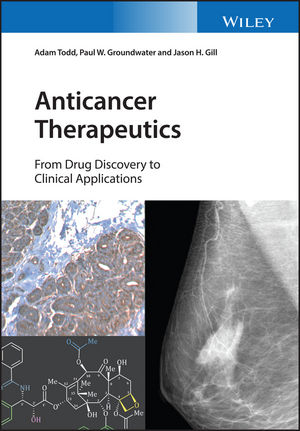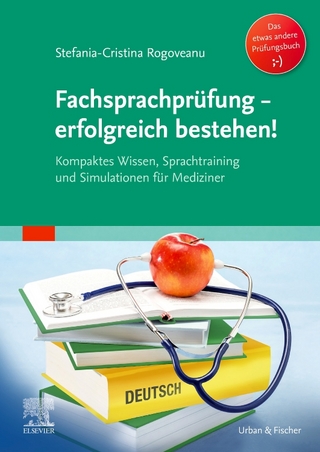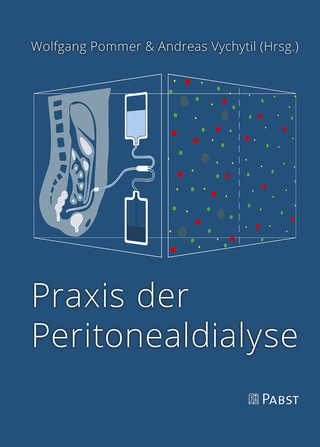
Anticancer Therapeutics
John Wiley & Sons Inc (Verlag)
978-1-118-62212-4 (ISBN)
Aimed at both undergraduate and postgraduate readers, this unique text provides readers with a fully-integrated presentation of all aspects of the science of anticancer drugs, including their chemistry, pharmacology, and clinical applications.
After heart disease, cancer is the number one killer worldwide, and the tumor microenvironment is forever changing, creating an ever-greater demand for safer, more effective anticancer agents. In response to that demand, the $100 billion cancer drug market continues to grow, with our increased understanding of cancer leading to new drugs being used clinically almost every year.
Anticancer Therapeutics is divided into three sections. Section 1 is an introduction to cancer and therapeutics, and covers the etiology and cellular and molecular basis of cancer. In Section 2, the authors focus on the anticancer agents — their discovery, synthesis, mode of action, mechanisms of resistance, and adverse reactions. Section 3 focuses on specific cancers, explaining how and why the various agents discussed in Section 2 are used, both individually and in combination, to treat different cancers.
Integrates aspects of basic science, including chemistry and pharmacology and clinical medicine in relation to cancer therapeutics
Written by an author team comprising specialists in medicinal chemistry, pharmacology, and oncology
Features full-color images throughout illustrating how drugs bind to cellular targets and exert their pharmacological effect
Divided into three sections, covering the etiology and cellular and molecular basis of cancer, anticancer agents, and drug applications for different cancers.
Providing the reader with an integrated understanding of all aspects of the science of anticancer agents, this is an ideal textbook for undergraduates studying medicine, nursing, medicinal chemistry, pharmacy, pharmacology and other allied heath / life sciences. It is also a valuable bench reference for pharmacists, medics, and pharmaceutical researchers working in both academia and industry.
Adam Todd, PhD is Senior Lecturer in Pharmaceutical Public Health in the School of Pharmacy, Faculty of Medical Sciences, at Newcastle University, UK. He is registered pharmacist, and specializes in oncology and palliative care. Paul W. Groundwater, PhD is Professor of Medicinal Chemistry in the Faculty of Pharmacy at The University of Sydney, Sydney, Australia. Jason H. Gill, PhD is a Reader in Molecular Therapeutics in the School of Pharmacy, Faculty of Medical Sciences, at Newcastle University, UK.
Preface xi
Section 1: Introduction 1
1.1 The Global Burden of Cancer 3
References 11
1.2 Cancer Staging and Classification 13
1.2.1 Benign Tumour (or neoplasm) 13
1.2.2 Malignant Tumour (or cancer) 14
1.2.3 Tumour Nomenclature and Classification 14
1.2.4 Cellular Differentiation and Tumour Grade 21
1.2.5 Tumour Invasion and Metastasis 24
1.2.6 Clinical Staging of Cancer 26
References 36
1.3 Cellular and Molecular Basis of Cancer 39
1.3.1 Oncogenes 40
1.3.2 Tumour Suppressor Genes 45
1.3.3 Role of Epigenetics and Gene Promoter Regulation in Tumourigenesis 49
1.3.4 Multistage Tumourigenesis 53
1.3.5 Oncogene Addiction 54
1.3.6 Hallmarks of Cancer 55
1.3.7 Principles of Cancer Treatment 73
References 77
Section 2: The Anticancer Agents 81
2.1 Agents Which Act Directly on DNA 83
2.1.1 Nitrogen Mustards and Nitrosoureas 83
References 96
2.1.2 Temozolomide 98
References 106
2.1.3 Platinum]containing Agents 108
References 118
2.1.4 Gemcitabine 120
References 128
2.1.5 Camptothecin and Its Analogues 128
References 139
2.1.6 Podophyllotoxins 141
References 150
2.1.7 Anthracyclines 151
References 160
2.1.8 Epigenetic Targeting Agents 162
References 177
2.2 Antimetabolites 181
2.2.1 Cytarabine 181
References 183
2.2.2 Methotrexate 184
References 195
2.2.3 5]Fluorouracil 196
References 205
2.2.4 6]Mercaptopurine 206
References 210
2.3 Antimicrotubule Agents 211
2.3.1 Taxanes 211
References 224
2.3.2 Vinca Alkaloids 225
References 231
2.4 Anti]hormonal Agents 233
2.4.1 Bicalutamide 233
References 239
2.4.2 Tamoxifen 240
References 247
2.4.3 Anastrozole 248
References 254
2.5 Kinase Inhibitors 257
2.5.1 Discovery 257
2.5.2 Synthesis 262
2.5.3 Mode of Action 267
2.5.4 Mechanism of Resistance 268
2.5.5 Adverse Drug Reactions 268
References 271
Section 3: The Cancers 275
3.1 Breast Cancer 277
Key points 277
3.1.1 Epidemiology 277
3.1.2 Presentation 279
3.1.3 Diagnosis 282
3.1.4 Staging 283
3.1.5 Treatments 285
References 289
3.2 Colorectal Cancer 293
Key points 293
3.2.1 Epidemiology 293
3.2.2 Presentation 294
3.2.3 Diagnosis 296
3.2.4 Staging 298
3.2.5 Treatments 299
References 303
3.3 Leukaemia 307
Key points 307
3.3.1 Epidemiology 307
3.3.2 Presentation 310
3.3.3 Diagnosis 311
3.3.4 Staging 313
3.3.5 Treatments 314
References 319
3.4 Lung Cancer 323
Key points 323
3.4.1 Epidemiology 323
3.4.2 Presentation 327
3.4.3 Diagnosis 327
3.4.4 Staging 330
3.4.5 Treatments 330
References 337
3.5 Oesophageal Cancer 339
Key points 339
3.5.1 Epidemiology 339
3.5.2 Presentation 340
3.5.3 Diagnosis 341
3.5.4 Staging 344
3.5.5 Treatments 346
References 350
3.6 Ovarian Cancer 353
Key points 353
3.6.1 Epidemiology 353
3.6.2 Presentation 354
3.6.3 Diagnosis 356
3.6.4 Staging 357
3.6.5 Treatments 357
References 363
3.7 Pancreatic Cancer 367
Key points 367
3.7.1 Epidemiology 367
3.7.2 Presentation 368
3.7.3 Diagnosis 370
3.7.4 Staging 371
3.7.5 Treatments 373
References 375
3.8 Prostate Cancer 379
Key points 379
3.8.1 Epidemiology 379
3.8.2 Presentation 381
3.8.3 Diagnosis 382
3.8.4 Staging 384
3.8.5 Treatments 387
References 391
3.9 Skin Cancers 393
Key points 393
3.9.1 Epidemiology 393
3.9.2 Presentation 394
3.9.3 Diagnosis 395
3.9.4 Staging 396
3.9.5 Treatments 399
References 403
3.10 Testicular Cancer 405
Key points 405
3.10.1 Epidemiology 405
3.10.2 Presentation 407
3.10.3 Diagnosis 407
3.10.4 Staging 409
3.10.5 Treatments 409
References 414
Index 417
| Erscheinungsdatum | 01.03.2018 |
|---|---|
| Verlagsort | New York |
| Sprache | englisch |
| Maße | 175 x 246 mm |
| Gewicht | 1021 g |
| Themenwelt | Medizin / Pharmazie ► Medizinische Fachgebiete |
| Naturwissenschaften ► Biologie | |
| Naturwissenschaften ► Chemie | |
| ISBN-10 | 1-118-62212-X / 111862212X |
| ISBN-13 | 978-1-118-62212-4 / 9781118622124 |
| Zustand | Neuware |
| Haben Sie eine Frage zum Produkt? |
aus dem Bereich


